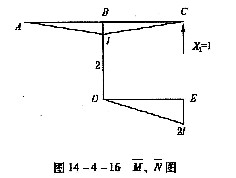问题
单项选择题
图14-4-15所示结构,杆DE为刚性杆,当支座E下沉△时,支座C的反力为()。


A.A
B.B
C.C
D.D
答案
参考答案:C
解析:
拆除支座C,以未知量X1代替其作用,可得到力法基本结构。作 图如图14-4-16所示。建立力法方程可得:δ11X1+△1C=0;
图如图14-4-16所示。建立力法方程可得:δ11X1+△1C=0;


图14-4-15所示结构,杆DE为刚性杆,当支座E下沉△时,支座C的反力为()。


A.A
B.B
C.C
D.D
参考答案:C
解析:
拆除支座C,以未知量X1代替其作用,可得到力法基本结构。作 图如图14-4-16所示。建立力法方程可得:δ11X1+△1C=0;
图如图14-4-16所示。建立力法方程可得:δ11X1+△1C=0;


| Geography is the study of the relationship between people and the land. Geographers compare and contrast various places on the earth. But they also (51) beyond the individual places and consider the earth as a whole. The English word geography means "to describe the earth. " (52) geography books focus on a small area like a town or city. Others deal with a state, a region, a nation, or an (53) continent. Many geography books deal with the whole earth. Another (54) to divide the study of geography is to distinguish between physical geography and cultural geography. The former focuses on the natural world; the (55) starts with human beings and studies how human beings and their environment act (56) each other. But when geography is considered as a single subject, (57) branch can neglect the other. A geographer might be described as one who observes, records, and explains the (58) between places. If all places (59) alike, there would be little need for geographers. We know, however, that no two places are exactly the same. Geography, (60) is a point of view, a special way of looking at place. |
A.still
B.then
C.nevertheless
D.moreover